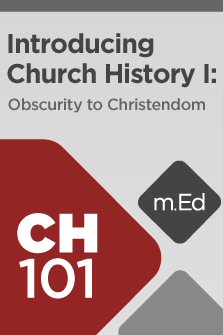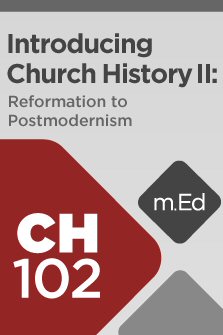Mobile Ed: Church History Bundle (2 courses)
Digital Logos Edition
Overview
How did the earliest Christians think about their faith, and how has that same faith produced the contemporary church? The history of Christianity is a story of ordinary people whose lives have been radically impacted by the life, death, and resurrection of Jesus. This is a dramatic story filled with heroic achievements as well as human frailty. By studying Christianity’s development from its earliest beginnings, we can live more faithfully into the unique needs of the 21st century.
In CH101 Introducing Church History I: Obscurity to Christendom, Dr. Frank A. James III covers the story of Christianity up to the Middle Ages. Beginning with the first Christians, Dr. James navigates the historical and theological turning points that led to the development of Christian doctrine, the rise of the papacy, the Crusades, and the beginning of church reform.
CH102 Introducing Church History II: Reformation to Postmodernism begins with the Reformation in its many forms: Martin Luther, the Swiss Reformation, the so-called Radical Reformers, and the Catholic Counter-Reformation. Dr. James then traces the post-Reformation church through the development of Arminianism, Puritanism, and the Great Awakening, concluding with a detailed look at the modern church.
Both of these courses are fully integrated into your existing Logos Bible Software, taking your studies and learning experience to new levels.
This title is included in the following collections
You can save when you purchase this product as part of a collection.
 Mobile Ed: Reformation Bundle ...$559.99$559.99
Mobile Ed: Reformation Bundle ...$559.99$559.99Church History: Foundational S...
$999.99$999.99Church History: Intermediate S...
$1,879.99$1,879.99Church History: Advanced Study...
$3,319.99$3,319.99
- $31,999.99

Individual Courses
- CH101 Introducing Church History I: Obscurity to Christendom by Frank A. James III
- CH102 Introducing Church History II: Reformation to Postmodernism by Frank A. James III
Product Details
- Title: Church History Bundle
- Instructors: Frank A. James III
- Publisher: Lexham Press
- Publication Date: 2016
- Product Type: Logos Mobile Education
- Resource Type: Courseware, including transcripts, audio, and video resources
- Courses: 2
- Video Hours: 13

Beginning with the aftermath of Jesus’ crucifixion and resurrection, CH101 covers the story of Christianity up to the 15th century. Dr. James unravels the distinct thought and persecution of the early Christians, as well as the key historical turning points that would result in the formation of doctrines such as the doctrine of Christ, the Holy Spirit, and the Trinity.
This course introduces you to the important work of Augustine, who responded to the Donatists and Pelagius in a way that would have lasting marks on the church. Dr. James traces the historical context of the rise of the papacy; the violence of the first Crusades and their lingering effects; and the rise of medieval scholasticism, particularly in the work of Thomas Aquinas. This course concludes with an explanation of the Great Schism of the 14th century and the early reform attempts by John Wycliffe and Jan Hus, which paved the way for the Protestant Reformation.
Contents:
Introduction
- Introducing the Speaker and the Course
Unit 1: Contours of the Early Church
- Expansion of the Early Church
- Explanations for Christian Expansion
- Using Lists and Search Operators to See God’s Heart for the Vulnerable
- Structure of the Early Church
- Worship in the Early Church
- Apostolic Fathers
Unit 2: Persecution in the Early Church
- Historical Context and Pagan Perceptions of Christians
- Parameters of Persecution
- Roman Persecution before AD 250
- Martyrdoms of Polycarp, Blandina, and Ponticus
- Empire-Wide Persecution Begins (AD 250)
- Identifying Times of Persecution Using the Timeline
- Establishment of the Tetrarchy
- The Great Persecution
- The Tetrarchy Undone
- Constantine and the Triumph of Christianity
Unit 3: Theological Diversions in the Early Church
- Judaizing Christians
- Gnosticism
- Gnostic Anthropology
Unit 4: Canon and Trinity
- Formation of the New Testament Canon: Part 1
- Formation of the New Testament Canon: Part 2
- The Trinity: Monarchianism
- The Trinity: Arian Controversy Unfolds
- The Council of Nicaea Decides
- The Resurgence and Eventual Defeat of Arianism
- Emperor Theodosius and the Council of Constantinople
Unit 5: Christology
- Apollinaris
- Nestorius
- Cyril versus Nestorius
- Eutyches
- The Council of Chalcedon
Unit 6: Aurelius Augustine
- Gateway to the Medieval Church
- The Life and Times of Augustine
- Creating Character Biography Reports with Factbook and Wikipedia
- Donatism
- Pelagianism
- Augustinianism
Unit 7: The Rise of the Papacy
- Leo I
- Gregory the Great and the Crowning of Charlemagne
- Papal Forgeries
- Pope Innocent III
Unit 8: The Crusades
- The First Crusades
- The Failure of the Crusades
Unit 9: Medieval Scholasticism
- The Rise of Scholasticism
- Thomas Aquinas and High Scholasticism
- Late Medieval Scholasticism: Ockham
Unit 10: Late Medieval Maelstrom
- European Crises and the Babylonian Captivity
- The Great Schism
- Attempts at Reform: Wycliffe
- Building a Custom Layout to Compare English Bible Translations
- Attempts at Reform: Hus
Conclusion
- “Saints” and Sinners

If you’ve ever wished you knew more about the events of the Protestant Reformation and how the Reformation produced the contemporary Protestant church, CH102 is for you. This course dispels popular misconceptions of Martin Luther’s intentions, and it provides a close look at Luther’s call from God which led him out of the monastery, his teaching on sola fide, and his eventual excommunication. Dr. James teaches you how to distinguish between Luther, the Swiss Reformers (including John Calvin, the “accidental reformer”), and the so-called Radical Reformers. He also provides a helpful explanation of the Council of Trent, the formation of the Jesuits, and the Catholic Counter-Reformation.
Dr. James then helps you navigate the historical and theological developments that led to Arminianism, English Puritanism, and Puritanism in New England. Learn how the spiritual decline in England led to John Wesley’s Methodism, the English Revival, and the Great Awakening in America, and get an in-depth look at Christianity in the modern era. After this course, you will be able to articulate how even through all of the twists and turns of the past 2,000 years, God is still working in the modern church.
Contents:
Introduction
- Introducing the Course
Unit 1: Luther’s Reformation
- Martin Luther: Peasant to Monk
- Sola Fide
- First Crisis of the Reformation
- Identifying Main Themes in Luther’s Ninety-Five Theses
- Luther’s Growing Defiance (1520)
- Luther’s Excommunication and “Patmos”
- The Peasants’ Revolt (1524–25)
- The Reformation of Marriage
- The Dark Side of Luther
- Luther’s Death
Unit 2: The Swiss Reformations
- The Swiss Confederation and Magisterial Reform
- Studying Sources of Authority Using Attachment Points in Notes
- The Origin of the Anabaptists
- Zwingli’s Death and Theological Distinctives
- Calvin: The Accidental Reformer
- Calvin’s Conversion and Genevan Turbulence
- Happy Days in Strasbourg
- Geneva Redux
- Calvin as Pastor
- The Execution of Servetus
- Calvin as Theologian
- Studying Calvin’s Theology with a Custom Guide and the Cited By Tool
- Calvin’s Evangelism and Missions
- Calvin’s Death and Legacy
Unit 3: Radical Reform
- Reformation and Revolution
- Michael Sattler and the Schleitheim Articles
- The Radical Kingdom of Münster
Unit 4: Catholic Counter-Reformation
- Catholic Reaction: The Jesuits
- The Council of Trent
- Pondering the Catholic Counter-Reformation
Unit 5: Refining the Reformation
- Historical Arc
- Arminianism
- Using the Favorites Tool to Study TULIP
- German Pietism
- Context of English Puritanism: Theology and Politics
- English Puritanism under King Charles I
- Three Phases of English Civil War
- New England Puritanism
- New England Puritans as Persecutors
- Methodism: Spiritual Decline in England and John Wesley
- Using Basic Searching to Study Wesley and Whitefield
- Methodism: Moravian Influence on John Wesley
- Methodism: George Whitefield
- English Revival and Theological Divergence
- The Great Awakening
- Whitefield and Wesley: Final Curtain Call
Unit 6: The Modern Church
- Protestant Liberalism
- Karl Barth
- Using Collections to Study Barth’s Theology
- Liberation Theologies
- Black and Feminist Theologies
- American Evangelicalism
- The Modernist-Fundamentalist Controversy
- Using Systematic Theologies to Identify Views of the Millennium
- Darwinian Evolution
- Neo-Evangelicalism: Part 1
- Neo-Evangelicalism: Part 2
- Postmodern Evangelicalism
- Women in Evangelicalism
- Ethnic Minorities in Evangelicalism
- New Centers of Global Christianity
- The Rise of Global Pentecostalism
- The Charismatic Movement
Conclusion
- God Is Still at Work
Reviews
5 ratings

Kevin Bratcher
6/12/2018

KeepOnSavingMe
1/19/2017
I have been listening to Church History 1 on mobile education monthly subscription, and enjoying it thoroughly. I have listened and read quite a bit of Church history, as it is one of my favorite subjects, and this is one of the most enjoyable, and seems to sum up Church history very well.
Edward Williams
7/14/2016

Deepak Kumar Singh
5/13/2016
I am enjoying the classes of Dr. Frank A. James III in Church History. He provides succinct, clear insights into the history of the Church in simple, uncluttered words which I find very helpful in understanding. He is himself very passionate about Church history and truly makes it come alive in his lectures. Highly recommended!!!

